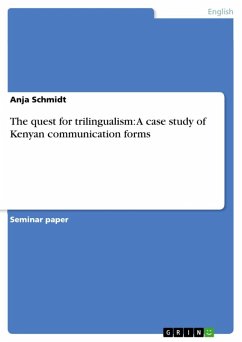Seminar paper from the year 2003 in the subject English Language and Literature Studies - Linguistics, grade: 1,0 (A), University of Hamburg (IAA), language: English, abstract: When considering the linguistic situation in Kenya, it becomes quite obvious that it is anything but homogenous. Not only the large variety of different ethnic groups, but also British colonial influences have left their marks on this diverse region. With English as the official language and Kiswahili as the national language, it seems that the language situation in Kenya should be clear cut and well defined. Yet, the search for a national identity, feelings of inferiority towards the "colonial" language English and the strive for a better political and economic life in Kenya confront the population with many challenges and problems. Kenyan society is shaped by 40 to 60 African ethnic languages, such as Maasai or Dholuo. The main means of communication among these different ethnic groups has become Kiswahili. But Kiswahili itself has seven dialects and several sub-dialects. In addition, several European languages were left behind by the colonial era and Arabic and Asian merchants have brought their languages with them too. Thus, the language situation in Kenya is extremely complex and considered to be a 3 + 1 language country. That means that most Kenyan citizens speak three languages (plus or minus one): the mother tongue (in most cases an African ethnic language), Kiswahili - the national language and most often also lingua franca, and English - the official language and therefore used for all educational and governmental purposes. But the competence and use of these communication systems varies largely. Like citizens of other imposed multilingual environment situations, Kenyans have developed their very own way to communicate with each other. But language is not only a pure means of communication - it carries different identities depending on social context. It serves to distinguish oneself from others as well as to express one's membership to a certain group and thus influencing one's understanding of culture. However, my aim in this paper is to analyse the current trilingualism in Kenya and explain the different levels of competence. I will put the main emphasis on English and Kiswahili, as they receive official recognition by the Kenyan government. When considering the interaction of the official languages and those inferior to them, I will also refer to some new language forms that might influence the Kenyan society considerably in the future.
Dieser Download kann aus rechtlichen Gründen nur mit Rechnungsadresse in A, B, BG, CY, CZ, D, DK, EW, E, FIN, F, GR, HR, H, IRL, I, LT, L, LR, M, NL, PL, P, R, S, SLO, SK ausgeliefert werden.









